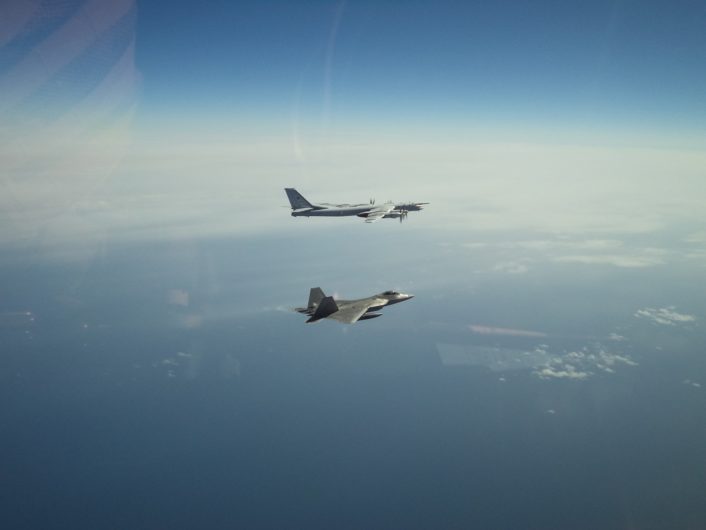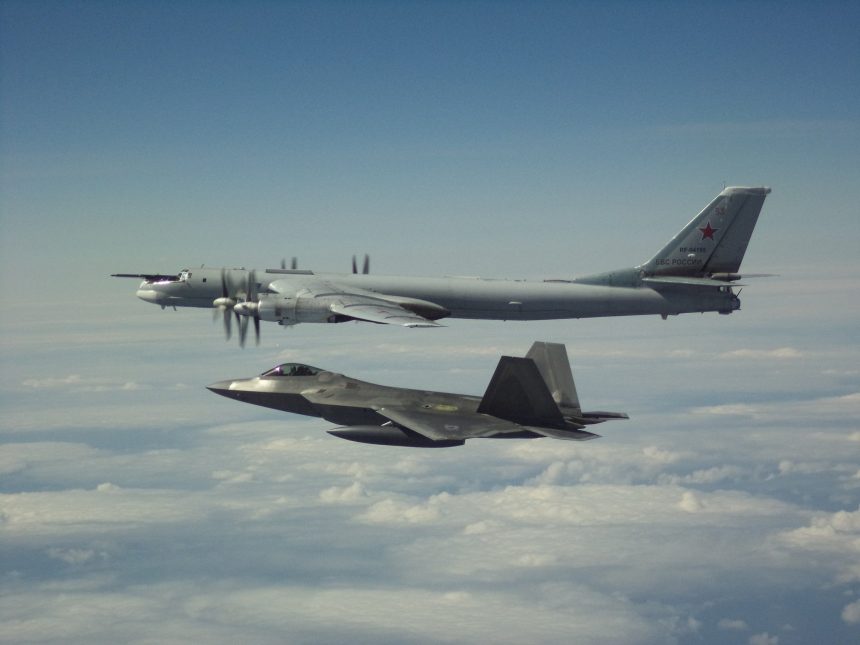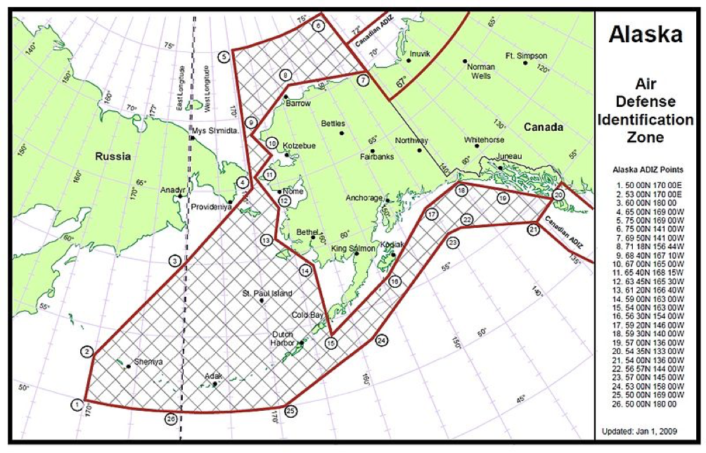Nothing to be worried about, just an opportunity to take some nice photographs.
On May 20, 2019, two pairs of F-22s and an E-3 Airborne Early Warning and Control System were scrambled from North American Aerospace Defense Command to carry out VIDs (Visual Identification) of a total of four Tupolev Tu-95 bombers and two Su-35 fighters entering the Alaskan Air Defense Identification Zone (ADIZ).
“Specifically, two of the Russian bombers were intercepted by two F-22s, and a second group of bombers with Su-35 fighters was intercepted later by two additional F-22s, while the E-3 provided overall surveillance. The Russian bombers and fighters remained in international airspace and at no time did the aircraft enter United States or Canadian sovereign airspace,” NORAD said in an official statement.
On the following day, “Two pairs of F-22 fighter jets, each with an E-3 Airborne Early Warning and Control System aircraft, from the North American Aerospace Defense Command (NORAD) positively identified and intercepted Russian Tu-95 bombers and Su-35 fighter jets entering the Alaskan Air Defense Identification Zone on May 21.”
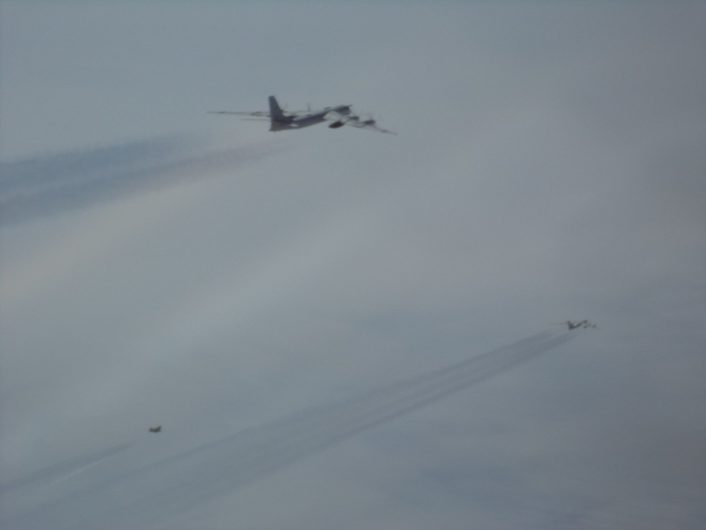
“Specifically, two Russian bombers entered the ADIZ and were intercepted by two F-22s while an E-3 provided overall command and control. The bombers exited and then re-entered the Alaskan ADIZ accompanied by two Su-35 fighter jets. NORAD committed an additional two F-22s and E-3 to relieve the initial intercept aircraft. A KC-135 air-to-air refueling aircraft supported both of NORAD’s intercept teams.”
Close encounters like the one on May 20 are not rare. The latest one we reported about took place in September 2018.
“NORAD has intercepted an average of approximately six to seven Russian sorties entering its ADIZ since Russia resumed long range aviation patrols in 2007. This is the fourth and fifth intercepts this year and the second day in a row that Russian bombers have flown into the Alaskan ADIZ.”
The ADIZ, is a special zone, that can extend well beyond a country’s territory where aircraft without authorization may be identified as a threat and treated as an enemy aircraft, leading to an interception and VID (Visual Identification) by fighter aircraft.
F-22s are among the aircraft in QRA (Quick Reaction Alert) scrambled by NORAD in support of Operation Noble Eagle, launched in the aftermath of 9/11 to prevent a recurrence of Sept. 11, 2001-style air attacks in U.S. and Canada. Raptors in peacetime QRA *usually* fly with external fuel tanks and Luneburg lenses/radar reflectors (clearly visible in all the released images): this means that they are (consciously) visible to radars, exactly as any other QRA aircraft.
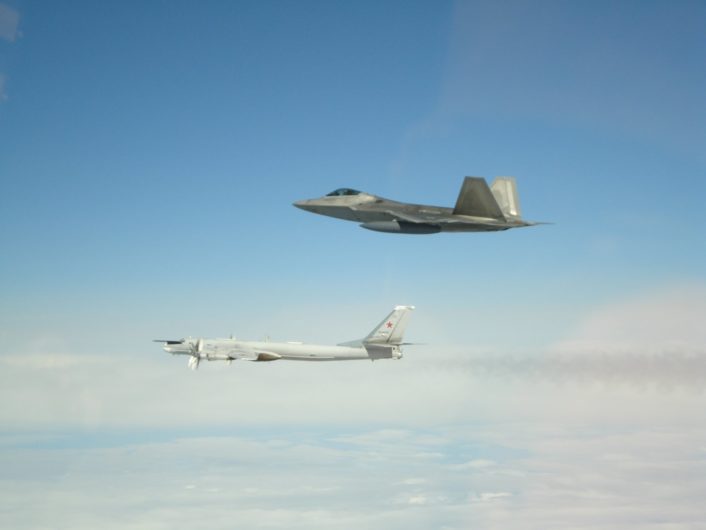
Needless to say, this is not the first time some Flanker jets support the Russian bombers on their long haul missions. Here’s what this Author wrote last time:
Such close encounters are quite frequent and may also involve fighters, as happened in 2017, when the Bears were escorted by two Su-35S Flanker-E jets, and an A-50 AEW (Airborne Early Warning) aircraft. Anyway, this is the second time that Russian Bears pay a visit to the Alaskan ADIZ: on May 12, 2018, two F-22s were launched to perform a VID and escort two Tu-95 on a similar mission in the Northern Pacific.
In fact, in May 2017, a “mini-package” of two Russian nuclear-capable Tu-95MS Bear bombers escorted by two Su-35S Flanker-E jets and supported by an A-50 Mainstay flew inside the Alaskan ADIZ (Air Defense Identification Zone), and was intercepted by two U.S. Air Force F-22 Raptors some 50 NM to the south of Chariot, Alaska.
Here’s what we wrote back then:
The Su-35 is a 4++ generation aircraft characterized by supermaneuverability. Although it’s not stealth, it is equipped with a Irbis-E PESA (Passive Electronically-Scanned Array) and a long-range IRST – Infrared Search and Tracking – system capable, (according to Russian sources…) to detect stealth planes like the F-35 at a distance of over 90 kilometers.
[…]
In my opinion the “mini package” was launched as a consequence of the increased flight activity in Alaska related to the Northern Edge exercise, confirming that the Russians closely observe what happens in the Alaskan area.
This time, they wanted to showcase their ability to plan a complex long-range sortie as well as the Flanker’s readiness to escort its own HVA (high value asset), the Bear, during operations at strategic distance.
The composition of this package is also worth a comment.
The presence of the Mainstay should not be underestimated. It was flying well behind the Flanker and Bear aircraft with a specific purpose. As an AEW (Airborne Early Warning) platform the A-50 is believed to embed some ESM (Electronic Support Measures): in other words, it is able to detect far away targets as well as able to sniff radar, radio and data link emissions. Furthermore, Raptors in QRA (Quick Reaction Alert) *usually* fly with external fuel tanks and Luneburg lenses: this means that they are (consciously) visible to radars. In such conditions, although it can’t “characterize” the clean F-22’s signature, the Mainstay can at least gather some data about the interceptors’ radar emissions (if any) and observe and study their tactics.
Therefore, as frequently happens on both sides since the Cold War, on May 3, the Russians most probably carried out another simulated long-range strike mission but with a precise ELINT (ELectronics INTelligence) objective: the Flankers and Bears were acting as a “decoy” package to test the American scramble tactics and reaction times, whereas the Mainstay, in a back position, tried to collect as much signals and data as possible about the US fighters launched to intercept them.
Interestingly, some aircraft showed up at Anadyr, a mixed-use civil-military airport in northeastern Russia. Although military aircraft are not known to be permanently based there, Anadyr frequently acts as a forward deploying base for Russian bombers and fighter aircraft.
Not saying these were part of today’s knock on Alaska’s door but suspicious aircraft show up at Anadyr on the 17th. looks like x3 fighters in flanker blue and x2 heavy airframes. My guess would be a tanker or two forward staged. @Aviation_Intel @TheAviationist pic.twitter.com/WsGa7ysG4U
— INTELLIPUS (@intellipus) May 21, 2019
That said, one thing is worth a note following the latest intercepts: as you can see in this post, unlike the most recent close encounters, at least this time NORAD has released some more photographs of the Raptors escorting the Bears.
